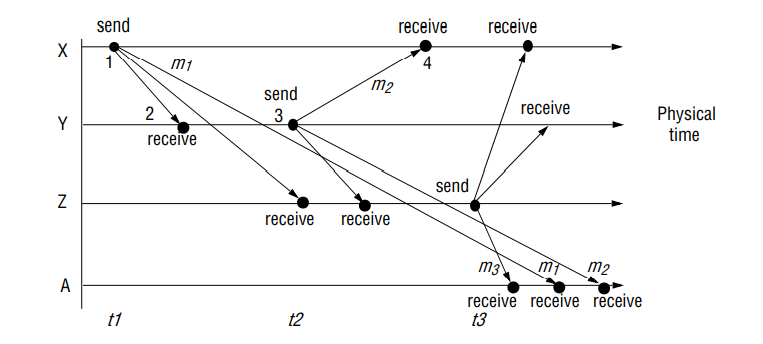Models of systems share some fundamental properties. In particular, all of them are composed of processes that communicate with one another by sending messages over a computer network. All of the models share the design requirements of achieving the performance and reliability characteristics of processes and networks and ensuring the security of the resources in the system.
The aspects of distributed systems that we wish to capture in our fundamental models are intended to help us to discuss and reason about:
Interaction: Computation occurs within processes; the processes interact by passing messages, resulting in communication (information flow) and coordination (synchronization and ordering of activities) between processes. In the analysis and design of distributed systems we are concerned especially with these interactions. The interaction model must reflect the facts that communication takes place with delays that are often of considerable duration, and that the accuracy with which independent processes can be coordinated is limited by these delays and by the difficulty of maintaining the same notion of time across all the computers in a distributed system
Failure: The correct operation of a distributed system is threatened whenever a fault occurs in any of the computers on which it runs (including software faults) or in the network that connects them. Our model defines and classifies the faults. This provides a basis for the analysis of their potential effects and for the design of systems that are able to tolerate faults of each type while continuing to run correctly
Security: The modular nature of distributed systems and their openness exposes them to attack by both external and internal agents. Our security model defines and classifies the forms that such attacks may take, providing a basis for the analysis of threats to a system and for the design of systems that are able to resist them.
Interaction model
Fundamentally distributed systems are composed of many processes, interacting in complex ways. For example:
- Multiple server processes may cooperate with one another to provide a service; the examples mentioned above were the Domain Name System, which partitions and replicates its data at servers throughout the Internet, and Sun’s Network Information Service, which keeps replicated copies of password files at several servers in a local area network.
- A set of peer processes may cooperate with one another to achieve a common goal: for example, a voice conferencing system that distributes streams of audio data in a similar manner, but with strict real-time constraints.
Performance of communication channels • The communication channels in our model are realized in a variety of ways in distributed systems – for example, by an implementation of streams or by simple message passing over a computer network. Communication over a computer network has the following performance characteristics relating to latency, bandwidth and jitter
Computer clocks and timing events • Each computer in a distributed system has its own internal clock, which can be used by local processes to obtain the value of the current time. Therefore two processes running on different computers can each associate timestamps with their events. However, even if the two processes read their clocks at the same time, their local clocks may supply different time values. This is because computer clocks drift from perfect time and, more importantly, their drift rates differ from one another. The term clock drift rate refers to the rate at which a computer clock deviates from a perfect reference clock. Even if the clocks on all the computers in a distributed system are set to the same time initially, their clocks will eventually vary quite significantly unless corrections are applied
Two variants of the interaction model • In a distributed system it is hard to set limits on the time that can be taken for process execution, message delivery or clock drift. Two opposing extreme positions provide a pair of simple models – the first has a strong assumption of time and the second makes no assumptions about time:
Synchronous distributed systems: Hadzilacos and Toueg [1994] define a synchronous distributed system to be one in which the following bounds are defined:
- The time to execute each step of a process has known lower and upper bounds
- Each message transmitted over a channel is received within a known bounded time
- Each process has a local clock whose drift rate from real time has a known bound.
Asynchronous distributed systems: Many distributed systems, such as the Internet, are very useful without being able to qualify as synchronous systems. Therefore we need an alternative model. An asynchronous distributed system is one in which there are no bounds on:
- Process execution speeds – for example, one process step may take only a picosecond and another a century; all that can be said is that each step may take an arbitrarily long time
- Message transmission delays – for example, one message from process A to process B may be delivered in negligible time and another may take several years. In other words, a message may be received after an arbitrarily long time
- Clock drift rates – again, the drift rate of a clock is arbitrary

